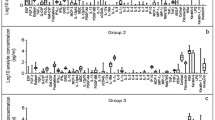Abstract
Severe itching for unknown reasons has been reported after administration of hydroxyethylstarch (HES) in haemodilution therapy of humans. In skin sections from patients who had received HES for otological reasons HES deposition was found by immunohistochemical methods in keratinocytes, epidermal dendritic cells, endothelial cells and macrophages. The aim of the present investigation was to study the interaction of cultured human monocytes and keratinocytes, normal (HNK) and malignant (KB, A431), with FITC-conjugated HES (200/0.5). Peripheral blood monocytes from healthy donors were isolated by Ficoll-Hypaque gradient centrifugation and adherence to plastic surfaces. Cells were incubated with HES-FITC (1 mg/ml) for 10, 20, 30, 60 and 120 min at 37‡C, washed several times to minimize cell-associated HES-FITC. The uptake of HES-FITC (200/0.5) was detected by fluorescence microscopy and flow cytometry. Monocytes and keratinocytes (HNK, KB, A431) acquired significant amounts of HES-FITC after 120 min. Endocytosis was blunted by the addition of unconjugated HES in ten-fold concentration. At 4‡C, a further inhibition was achieved, indicating an uptake of HES-FITC by monocytes and keratinocytes in vitro. These results indicate that a connection between the storage of HES by keratinocytes and monocytes and the observed itching in patients might be possible.
Similar content being viewed by others
References
Amlot PL, Grennan D, Humphrey JH (1985) Splenic dependence of the antibody response to thymus-independent (TI-2) antigens. Eur J Immunol 15: 508–512
Ansel J, Perry P, Brown J, Damm D, Phan T, Hart D, Luger T, Hefeneider S (1990) Cytokine modulation of keratinocyte cytokines. J Invest Dermatol 94: 101S–107S
Arams JT, Lessin S, Ghosh SK, Ju W, Vonderheid EC, Nowell P, Murphy G, Elfenbein B, DeFreitas E (1991) A clonal CD4-positive T-cell Line established from the blood of a patient with Sézary Syndrome. J Invest Dermatol 96: 31–37
Baumgartner I, Scheiner O, Holzinger C, Boltz-Nitulescu G, Klech H, Lassmann H, Rumpold H, Förster O, Kraft D (1988) Expression of the VEP13 antigen (CD16) on native human alveolar macrophages and cultured blood monocytes. Immunobiol 177: 317–326
Csató M, Bozóky B, Hunyadi J, Dobozy A (1986)Candida albicans phagocytosis by separated human epidermal cells. Arch Dermatol Res 279: 136–139
DeBelder AN, Granath K (1973) Preparation and properties of fluorescein-labeled dextrans. Carbohydr Res 30: 375–378
Hermann J, Gall H (1990) Diagnose und Therapie des persistierenden Pruritus nach Infusion von HydroxyÄthylstÄrke (HÄS). Aktuel Dermatol 16: 166–167
Hong B, Zhang T (1988) Studies on the side-effect of hydroxyethyl starch injections. Yaoxue Tongbao 23: 51
Hulse JD, Jacobi A (1983) An overview of the colloid and its metabolism. Drug Intell Clin Pharm 17: 334–341
Humphrey JH, Grennan D (1981) Different macrophage populations distinguished by means of fluorescent polysaccharides. Recognition and properties of marginal-zone macrophages. Eur J Immunol 11: 221–228
Jurecka W, Szépfalusi Z, Parth E, Schimetta W, Gebhart W, Scheiner O, Kraft D: Hydroxyethylstarch deposits in human skin — a model for pruritus? Arch Dermatol Res 285: 13–19
Knopf B, Wollina U (1990) Der Keratinozyt — Eine biologisch aktive Zelle Dermatol Monatsschr 176: 453–459
Kroemer H, Haa\ A, Müller K, JÄger H, Wagner EM, Heimburg P, Klotz U (1987) Hemodilution therapy in ischemic stroke: pharmacokinetics and plasma viscosity during long term infusion of dextran 40 or hetastarch 200/0.5. Eur J Clin Pharmacol 31: 705–711
Kupper T (1990) The activated keratinocyte: a model for inducible cytokine production by non-bone marrow-derived cells in cutaneous inflammatory and immune responses. J Invest Dermatol 94: 146S–150S
Leslie RGQ (1980) Macrophages handling of soluble immune complexes. Ingestion and digestion of surface bound complexes at 4‡, 20‡, and 37‡. Eur J Immunol 10: 323–333
Luger T, Schwarz T (1991) Epidermal cell derived secretory regulins. In: Schuler G (ed) Epidermal Langerhans cells. CRC Press, Boca Raton, pp 217–251
Nakasato SK (1982) Evaluation of hetastarch. Clin Pharmacol 1: 509–514
Parker NE, Porter JB, Williams HJM, Leftley M (1982) Pruritus after administration of hetastarch. BMJ 284: 385–386
Parth E, Jurecka W, Szépfalusi Z, Schimetta W, Gebhart W, Scheiner O, Kraft D (1992) Histological and immunohistochemical investigations of hydroxyethylstarch deposits in rat tissues. Eur Surg Res 24: 13–21
Potter B, Medenica M (1968) Ultramicroscopic phagocytosis of synthetic melanin by epidermal cell in vivo. J Invest Dermatol 51: 300–303
Preston RA, Murphy RF, Jones EW (1987) Apparent endocytosis of fluorescein isothiocyanate-conjugated dextran by saccharomyces cerevisiae uptake of low molecular weight impurities, not dextran. J Cell Biol 105: 1981–1987
Schaeffer RC, Renkiewicz RR, Chilton S, Marsh D, Carlson RW (1986) Preparation and high-performance size-exclusion chromatographic (HPSEC) analysis of fluorescein isothiocyanate-hydroxyethyl starch: macromolecular probes of the blood-lymph barrier. Microvasc Res 32: 230–243
Sirtl C, Hübner G, Jesch F (1988) Zur Speicherung von hoch- und mittelmolekularer HydroxyÄthylstÄrke (HÄS) im menschlichen Gewebe. Beitr Anaesth Intensivmed 26: 74–97
Steinman RM, Cohen ZA (1972) The uptake, distribution and fate of soluble horseradish peroxidase in mouse peritoneal macrophages in vitro. J Cell Biol 55: 186–204
Steinman RM, Mellman IS, Muller WA, Cohn ZA (1983) Endocytosis and the recycling of plasma membrane. J Cell Biol 96: 1–27
Strauss RG, Snyder EL, Stuber J, Fick RB (1986) Ingestion of hydroxyethylstarch by human leucocytes. Transfusion 26: 88–90
Wahlgren C-F (1992) Pathophysiology of itching in urticaria and atopic dermatitis. Allergy 47: 65–75
Author information
Authors and Affiliations
Rights and permissions
About this article
Cite this article
Szépfalusi, Z., Parth, E., Jurecka, W. et al. Human monocytes and keratinocytes in culture ingest hydroxyethylstarch. Arch Dermatol Res 285, 144–150 (1993). https://doi.org/10.1007/BF01112917
Received:
Issue Date:
DOI: https://doi.org/10.1007/BF01112917




